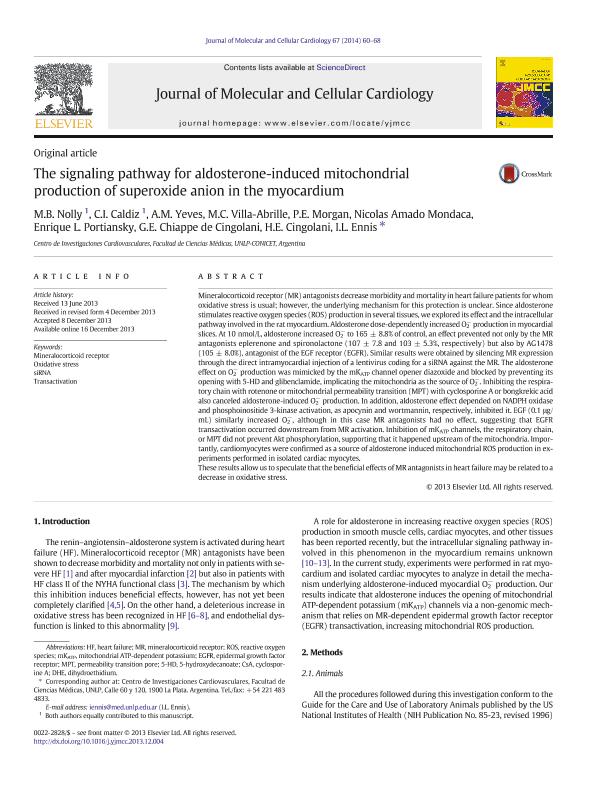Artículo
The signaling pathway for aldosterone-induced mitochondrial production of superoxide anion in the myocardium
Nolly, Mariela Beatriz ; Caldiz, Claudia Irma
; Caldiz, Claudia Irma ; Yeves, Alejandra del Milagro
; Yeves, Alejandra del Milagro ; Villa Abrille, M. C.; Morgan, Patricio Eduardo
; Villa Abrille, M. C.; Morgan, Patricio Eduardo ; Mondaca, Nicolás Amado; Portiansky, Enrique Leo
; Mondaca, Nicolás Amado; Portiansky, Enrique Leo ; Chiappe, Gladys Ethel
; Chiappe, Gladys Ethel ; Cingolani, Horacio Eugenio
; Cingolani, Horacio Eugenio ; Ennis, Irene Lucia
; Ennis, Irene Lucia
 ; Caldiz, Claudia Irma
; Caldiz, Claudia Irma ; Yeves, Alejandra del Milagro
; Yeves, Alejandra del Milagro ; Villa Abrille, M. C.; Morgan, Patricio Eduardo
; Villa Abrille, M. C.; Morgan, Patricio Eduardo ; Mondaca, Nicolás Amado; Portiansky, Enrique Leo
; Mondaca, Nicolás Amado; Portiansky, Enrique Leo ; Chiappe, Gladys Ethel
; Chiappe, Gladys Ethel ; Cingolani, Horacio Eugenio
; Cingolani, Horacio Eugenio ; Ennis, Irene Lucia
; Ennis, Irene Lucia
Fecha de publicación:
02/2014
Editorial:
elsevire
Revista:
Journal Of Molecular And Cellular Cardiology
ISSN:
0022-2828
Idioma:
Inglés
Tipo de recurso:
Artículo publicado
Clasificación temática:
Resumen
Mineralocorticoid receptor (MR) antagonists decrease morbidity and mortality in heart failure patients for whom oxidative stress is usual; however, the underlying mechanism for this protection is unclear. Since aldosterone stimulates reactive oxygen species (ROS) production in several tissues, we explored its effect and the intracellular pathway involved in the rat myocardium. Aldosterone dose-dependently increased O2− production in myocardial slices. At 10 nmol/L, aldosterone increased O2− to 165 ± 8.8% of control, an effect prevented not only by the MR antagonists eplerenone and spironolactone (107 ± 7.8 and 103 ± 5.3%, respectively) but also by AG1478 (105 ± 8.0%), antagonist of the EGF receptor (EGFR). Similar results were obtained by silencing MR expression through the direct intramyocardial injection of a lentivirus coding for a siRNA against the MR. The aldosterone effect on O2− production was mimicked by the mKATP channel opener diazoxide and blocked by preventing its opening with 5-HD and glibenclamide, implicating the mitochondria as the source of O2−. Inhibiting the respiratory chain with rotenone or mitochondrial permeability transition (MPT) with cyclosporine A or bongkrekic acid also canceled aldosterone-induced O2− production. In addition, aldosterone effect depended on NADPH oxidase and phosphoinositide 3-kinase activation, as apocynin and wortmannin, respectively, inhibited it. EGF (0.1 μg/mL) similarly increased O2−, although in this case MR antagonists had no effect, suggesting that EGFR transactivation occurred downstream from MR activation. Inhibition of mKATP channels, the respiratory chain, or MPT did not prevent Akt phosphorylation, supporting that it happened upstream of the mitochondria. Importantly, cardiomyocytes were confirmed as a source of aldosterone induced mitochondrial ROS production in experiments performed in isolated cardiac myocytes.
These results allow us to speculate that the beneficial effects of MR antagonists in heart failure may be related to a decrease in oxidative stress.
Palabras clave:
Mineralocorticoid Receptor
,
Oxidative Stress
,
Sirna
,
Transactivation
Archivos asociados
Licencia
Identificadores
Colecciones
Articulos(CIC)
Articulos de CENTRO DE INVEST.CARDIOVASCULARES (I)
Articulos de CENTRO DE INVEST.CARDIOVASCULARES (I)
Citación
Nolly, Mariela Beatriz; Caldiz, Claudia Irma; Yeves, Alejandra del Milagro; Villa Abrille, M. C.; Morgan, Patricio Eduardo; et al.; The signaling pathway for aldosterone-induced mitochondrial production of superoxide anion in the myocardium; elsevire; Journal Of Molecular And Cellular Cardiology; 67; 2-2014; 60-68
Compartir
Altmétricas



